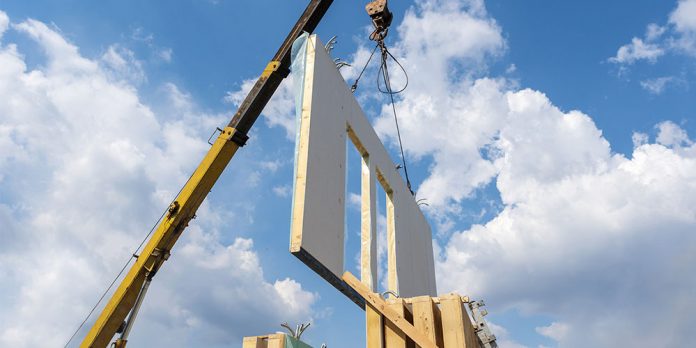Hager recently hosted a roundtable debate to discuss the potential of offsite construction to help alleviate pressure on Britain’s housebuilding sector. Here, Jane Yorke, residential market manager at Hager, explores some of the key topics debated
The government is committed to building 300,000 new homes each year by the middle of this decade, but there are already signs that achieving such a target will be a challenge.
As the pressure to meet the annual housing construction target continues to intensify, the spotlight is focussing on alternative methods to improve efficiencies and productivity in the process and speed-up completion of much-needed new homes to meet escalating demand.
A growing area of interest is the contribution offsite construction can make; with experts advocating that it can play a key role going forward by helping to ease the pressure on traditional building practices. If the conditions are right, many feel that offsite construction – while not a new concept – can nonetheless produce excellent results and replicate the proven success and effectiveness already seen in the automotive sector, an industry which has embraced offsite manufacturing for a number of years.
Growing the market
If the offsite construction market is to play a meaningful role in the successful delivery of ambitious government housebuilding targets, it will need to gain traction and grow sufficiently. There is an acceptance that such success will rely on progress being made in two specific areas: early engagement and collaboration across multi-discipline project and supply teams, and a standardised approach for both products and the sector’s overarching regulatory system.
Early engagement and collaboration
One of the areas highlighted at the roundtable debate as a key component in the success of any offsite construction project, is the vision and commitment of the project client.
If clients have the ambition to drive and support offsite manufacture from the outset, it can set the tone that pushes the project through to completion. Yet, it was also noted that evidence of such commitment needs to include discussions around delivery of an offsite solution taking place in advance of any detailed design process. As a result, this can also help to optimise design outcomes and ease any potential conflicts resulting from supply chain discipline crossover.
Early collaboration with key specialists across the supply chain can lead to high-level coordination and successful design, providing a detailed design at a far earlier stage in the process. This creates both supply chain trust and cost certainty which can underpin the project throughout its entirety, as well as provide future investor confidence to embark on other projects.
The result of early partnership would result in flexibility in product supply across all disciplines and see consultants produce a higher level of design to ensure the project is optimised, removing the need to return to initial designs at level three or four when it may be too late or costly to alter them.
Standardisation
Linked to the need for greater and earlier collaboration across the supply chain, participants in the debate also noted the importance of driving standardisation in many areas, including product information.
This would see product manufacturers move to standardise and share the information around components, not only across the supply chain but also with other manufacturers.
By being more open and prepared to knowledge share, suppliers can make a significant contribution to better outcomes and, at the same time, continue to secure new business. As such, accurate material and product details around origin, content and embodied energy needs to be more widely available and shared to better inform project leaders and meet client demands.
While the need for closer and earlier collaboration and a more standardised approach across the sector will be the key drivers for success, other areas such as leadership and sustainability will also be influential when it comes to promoting growth opportunities and offsite construction’s ability to establish itself alongside traditional building methods.
Lead from the top
Another area which gathered much debate was the call for a more joined-up and collaborative approach, which is deemed essential to realise the true potential of offsite construction. It is also dependent on the many regulatory bodies that govern the housing and construction sectors working together to provide direction, vision and an enabling ‘can-do’ operating environment.
A common language to distil and reduce the varying terminology currently used across the sector would be helpful, as well as efforts by various bodies to present a united front for a sector that still has too many disparate voices.
Leading the way in helping to lobby for the further alignment of current building regulations and standards would create a more even playing field, provide certainty for all stakeholders and underpin future investment ambitions.
Think green
With continued focus on meeting government carbon emission targets, the housing construction sector continues to be in the spotlight when it comes to delivering a more sustainable future. For example, the Future Homes Standard has outlined the banning of gas-fired boilers in new homes among other efforts to help meet the national carbon emission reduction target set by the government. While the shared goal of achieving significant carbon reductions and increased sustainability credentials, is to be welcomed, it also necessitates new and innovative approaches as to how we will construct and run our homes in the years to come.
To this end, increasingly, clients are not only seeking solutions and partners who are able to deliver bespoke solutions, but ones who are also able to satisfy end-of-life status and the reusability of specified materials and products.
This will be a primary focus for clients looking to invest in and develop offsite construction solutions. It should also be a central consideration for product suppliers looking to secure business.
Optimistic outlook
The future of offsite manufacturing and its ability to drastically influence the course of Britain’s housebuilding requirements can be an optimistic one.
It will take early and sustained collaboration, partnership, intervention and, sharing of knowledge to continue to gain in traction as the go-to construction method. At the same time, all stakeholders must be mindful of some potential barriers to success that include building regulation constraint, current procurement practices and existing workforce skill sets.
However, offsite construction has the potential to stand shoulder to shoulder with traditional construction methods if it can focus on building greater efficiencies underscored by a belief in collaboration and, a standardisation of approach and products across the supply chain.
‘Come together to build better outcomes’ is available to download here.

Jane Yorke
Residential market manager














